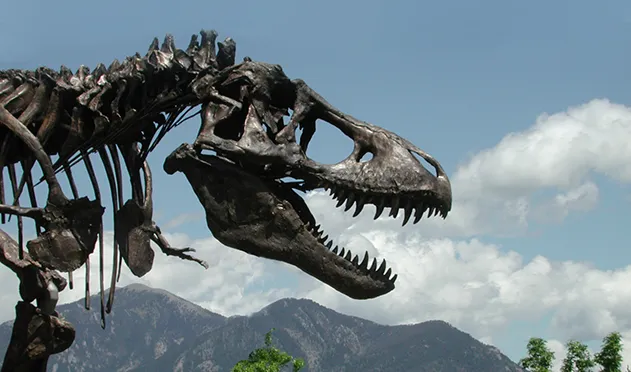After 103 Years, the Natural History Museum Finally Gets Its Own Tyrannosaurus rex
The “Wankel Rex,” discovered in Montana in 1988, is one of just a dozen complete skeletons worldwide
/https://tf-cmsv2-smithsonianmag-media.s3.amazonaws.com/filer/TRex-NMNH-Big-Mike-2-631.png)
On October 16, a truck hauling some rather remarkable cargo will arrive in Washington, D.C. At the world’s most-visited natural history museum, workers will carefully unload boxes that carry the fossilized bones of the world’s most iconic dinosaur, the 66 million-year-old Tyrannosaurus rex. After a stay at the Museum of the Rockies in Bozeman, Montana, the 38-foot-long, 7-ton skeleton will live at the Smithsonian National Museum of Natural History for 50 years, giving millions of visitors the chance to appreciate its grandeur and sheer size firsthand.
“If you've ever stood next to a real T. rex skull, you'll realize what a breathtaking thing it is: four feet long, with teeth the size of bananas,” says Kirk Johnson, Sant director of the museum and a paleontologist himself. “It is the most terrifying carnivore that's ever lived on the planet. And it really makes you ponder what life would have been like with these things prowling the North American landscape.”
The loan comes after decades of attempts by the museum to acquire one of the dozen or so relatively complete T. rex fossils that exist worldwide. The specimen, officially designated MOR 555, is commonly known as “Wankel’s Rex,” because it was found in 1988 by amateur fossil hunter Kathy Wankel in Montana.
“She and her family were out boating on Fort Peck reservoir, and they stopped on an island to look around a little bit, and she found some bones,” says Shelley McKamey, the director of the Museum of the Rockies. “She brought them to the museum to be identified, and I remember our curator Jack Horner asking her ‘Can you find this site again?’ because what she'd brought in were the first arm bones of a T. rex ever found.”
The area with exposed rock from the Late Cretaceous epoch is “chock-full of dinosaurs,” according to Johnson; it was also the site of several other T. rex fossil discoveries, including the species’ type specimen, found and excavated in 1902. Horner led the excavation of Wankel’s Rex, which, when finally unearthed, proved to be what was then the largest and most complete T. rex fossil in existence.
Because the reservoir was under the control of the U.S. Army Corps of Engineers at the time, the fossil became federal property, though it was stored at the Museum of the Rockies. Through a joint agreement with the Army Corps of Engineers, Montana State University and the Museum of the Rockies—which has a second T. rex specimen of its own—Wankel’s Rex will now be donated to the Smithsonian and reside permanently in the nation’s capital.
The specimen is roughly 85 percent intact, and though it has been surpassed by subsequent finds, it is still among the most complete T. rex fossils ever found. “It’s a really nice specimen in the sense that it's got a lot of the body, head to tail,” Johnson says. The creature has a disarticulated skull, meaning that its skull bones separated before it fossilized—so they aren’t attached—but each one is present.
Furthermore, new technological advances will allow Smithsonian researchers to fill in any gaps to produce a complete and accurate skeleton. “Once we unpack it, we’ll begin by digitally scanning every bone and producing a virtual T. rex,” Johnson says. “Then, if you're missing bones and want to recreate the whole animal, you can essentially take the opposite bone and flip the image.” Adam Metallo and Vince Rossi, the “laser cowboys” of the 3D Lab in the Smithsonian’s Digitization Program Office who work at the forefront of museum digitization, have already used this type of technology to digitally preserve everything from fossilized whales excavated in Chile to many of the skeletons that currently fill the museum’s Dinosaur Hall. Once fully digitized, the 3-D data points that capture the contours of the T. rex can be used to print replicas at any scale, from full size to desktop, a major asset for both educational and research purposes.
Digitizing the T. rex is one of the first steps in studying the skeleton to better understand the legendary species as a whole. “It’s the most famous dinosaur of all time, and yet we don't really know the details of the differences between the known skeletons,” Johnson says. “So ideally what we'd like to do is scan all the known skeletons and get a good sense of the variation between them.” Smithsonian scientists will also conduct the sort of conventional anatomical research on the T. rex that has led to a number of noteworthy discoveries by other researchers in recent years, such as the change in our understanding of its posture (bent over, parallel to the ground, rather than upright, like a kangaroo) and the fact that dinosaur bones feature growth rings inside, which can tell us how large the animal was at any given age and its age at death.
Apart from research, the T. rex will also serve as a key educational tool for the thousands of visitors who come through the National History Museum’s doors daily. Although the fully mounted skeleton won’t be on view until 2019, the museum will create a series of temporary displays over the next few years that will feature parts of the skeleton, along with digital renderings, including a fall 2016 exhibition about the T. rex and its environment. But in due time, the T. rex will assume its permanent position, one befitting a creature with a name that translates as “the king of reptiles,” towering over dozens of other dinosaur fossils, as the centerpiece of the Dinosaur Hall.
/https://tf-cmsv2-smithsonianmag-media.s3.amazonaws.com/accounts/headshot/joseph-stromberg-240.jpg)


/https://tf-cmsv2-smithsonianmag-media.s3.amazonaws.com/accounts/headshot/joseph-stromberg-240.jpg)